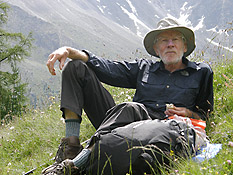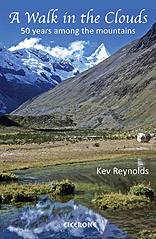
TRAIL TALES
MULES, FROGS AND BIVVY BAGS
Twenty-one years after my first visit to the Atlas Mountains of Morocco which had such a profound effect on my life, I found myself drawn again to these mountains, this time with a trekking party; my commission to write a piece about the experience for a magazine. Exactly twice as old as I’d been on that initial visit, I was well aware that my enthusiasm for mountain travel had not dimmed in the slightest, and Morocco’s high places were every bit as rewarding as they had been in 1965.
It was a good hour or so before the mules caught up. We were making the most of the shade cast by a solitary juniper tree not two metres high when we saw them. Mules first, behind came the muleteers striding in cream-coloured djellabas and home-made sandals with Michelin-tread soles; around them hung the Atlas smell of warm leather and fresh dung mingled with dust that rose in low clouds disturbed by sixteen shod hooves. The lead mule halted. The others stopped too, snorting and shaking their manes that set bells tinkling until a well-aimed stone and a whistle through closed teeth from Ibrahim got them moving again. I stood up and followed at a discreet distance, hoping to avoid a lung full of that dust.
It was better on the pass, the air a little cooler with a vague breeze flowing across scrub-pocked slopes, but a summer haze restricted views beyond the second of what I imagined would be countless ridges before the mountains fell on the edge of the desert. I thought I could smell rain. Ten minutes later the first drops fell, so large and well-spaced, you could actually count them as they made damp craters in the trail, the edges of which collapsed inwards the instant they dried. A few rumbles of thunder could be heard behind us, muffled by summits nearly four thousand metres high. Not wanting to be caught here by the storm, we headed down into the misting valley, the mules forging ahead, muleteers holding onto tails, talking all the while.
There was no more thunder, but it rained all the way down. Not the heavy rain predicted by those initial forerunner drops on the pass, but a steady, persistent drizzle that soaked shirts and steamed glasses. Too warm to bother with waterproofs, wet clothing was acceptable, but towards evening, once we’d chosen a site for our bivouac on a meadow where two streams met at a confluence of valleys, dry shirts and anoraks came on, and we began to prepare a meal.
Rain continued to fall while the meal was cooked. Clouds lowered over the mountains and brought an early nightfall. It rained while we ate, and it was still raining when we slid into bivvy bags beneath a star-free sky. Frogs slipped into the water and eyed their new neighbours from a low vantage point.
The mules were hobbled for the night, but you could hear their teeth tearing at the short grass, followed by the unmistakable sound of digestive tracts gurgling and the odd fart too close for comfort. I made a mental note not to sleep near a mule again.
Our bivvy site was a rarity in this corner of the Atlas Mountains; it consisted of soft, fairly level turf and a pair of meandering streams. Wild mint grew along the margins of one, tall thistles with bulbous heads stood in clumps alongside the other. There was no village, so no terracing or ditches for irrigation on the hillsides; no trees nor shrubs, but a half-circular wall of rocks about knee-high suggested there had once been a shelter here; perhaps for a shepherd.
Headtorches went out one by one, and at last even the voices of the muleteers fell silent. Yet sleep was elusive. Lying there with just my head projecting from the bivvy bag, I was content with the warm rain on my face, and the stream sliding gently past less than an arm’s length away. The rain was of no concern. Almost soothing, it threatened no flooding, and I was sure it would be gone by daybreak. So I lay there rewinding our journey of the past five days, only vaguely anticipating days ahead and content with the now of being, when suddenly thoughts were interrupted when a frog leapt from the water and landed on my forehead.
The rest of the night was spent with my head inside the bivvy bag.
This is one of 75 autobiographical short stories describing encounters that have taken place in mountain regions throughout the World over the past 50 years, published in August 2013 by Cicerone under the title: A Walk in the Clouds. Return to this site next month for another tale from this collection.
